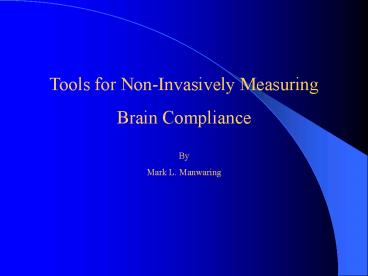Tools for Non-Invasively Measuring - PowerPoint PPT Presentation
1 / 29
Title:
Tools for Non-Invasively Measuring
Description:
Encompasses many areas of specialization. Software development, systems development and hardware selection, studies of ... (cochlear endolymph ossicles tymembrane). 5. ... – PowerPoint PPT presentation
Number of Views:32
Avg rating:3.0/5.0
Title: Tools for Non-Invasively Measuring
1
Tools for Non-Invasively Measuring Brain
Compliance By Mark L. Manwaring
2
- What is Engineering?
- To contrive or plan out usually with more or less
subtle skill and craft to guide the course. - Systematic study of algorithmic processes that
describe and transform information their theory,
analysis, design, efficiency, implementation, and
application. - Encompasses many areas of specialization.
Software development, systems development and
hardware selection, studies of compatibility
between hardware and software, language
development and modification, or perhaps a
combination of these and any number of other
diverse applications and concepts. - Must be familiar with the language of the
physical sciences, mathematics, and English.
3
Normal fetal brain
4
A Ventriculoperitioneal (VP) Shunt
5
Over drainage and slit ventricles a statistical
setup for repeat surgery
6
Detection of shunt failure
- Standard practice rests on history, clinical
exam, and CT scan changesunreliable on initial
assessment ¼ of time - ICP measurement is definitive, but invasive and
impractical prior to ER
7
Optimizing outcome of hydrocephalus
- Avoidance of complications at surgery
malposition and infection - Avoidance of longterm complications of
obstruction and overdrainage - Simplify and eliminate shunts where possible
(evolving role of third ventriculostomy and
related surgeries) - Optimize hydrocephalus control for cognitive
outcome - Wean shunts to ligation and removalthe cure?
8
The Ear is a Speaker -- a recent discovery
- Internal carotid artery and its distral tributary
is the generator of the ICP pulse inside the
cranium. - Pulse travels through CSF and brain.
- Tissues change the ICP waveform morphology
dependent on brain complianceincreased amplitude
and risetime. - CSF waveform transmitted backwards across hearing
apparatus - (cochlear endolymph?ossicles?tympanic membrane).
- 5. ICP pulsation not perceived due to
frequency below hearing threshold (20 Hz to 20
kHz).
9
General Ear Anatomy
Middle Inner Ear CSF pulse travels into
endolymph
10
Measuring the Output of the EarOur Prototype
- Head band with microphone for detection of low
frequency ICP pulse.
11
Ear microphone allows tracings from both ears
simultaneously.
12
Unfiltered signals Piezo sensor tympanic
membrane and ICP sensor
13
The brain stethoscope an apparatus and method
for outpatient and home ICP monitoring
14
ICP vs earlobe pulse standing upright
15
Vertical Position
- Coray
Jotham
16
Horizontal Position
- Coray
- Jotham
17
Minus 45 degreesintracranial pressure exceeds 27
cm H2O (20 mm Hg)
18
Completely invertedICP greater than 45 cm (31
mmHg) CPP lt50 mm Hg cerebral congestion
retinal petichiae after prolonged period
19
Blue signal from external ear canal Green
pulse oximeter
20
Phase relationship between TMD and pulse oximeter
at 45
21
Phase relationship in horizontal positionNote
increased amplitude but no phase shift
22
Inversion to -45Marked phase shift
23
Complete inversion -90 Further phase shift
seen
24
27 males, age 18-25. Five positions 45, 0,
-15, -30, -45
25
27 males, the average and /- 1 SD
26
Hysteresis of phase shift in a subject moved from
horizontal to -45 and back, pausing 30sec in
each position
27
Patients with VP shunts showed three patterns
Poor compliance, normal range, and overdrainage
28
A Prototype Hardware/Software System to Capture
and Display Compliance Information
29
Issues to be worked on --
- A better method than using the FFT for
determining phase angles - Measuring ICP with pulse oximeters
- A long-term, implantable measuring device
associated with the shunts. - Theory the head is resonant chamber. Can the
problem of hydrocephalus be cured by fixing the
resonance problem?































